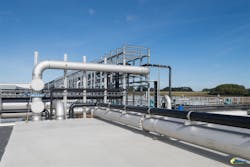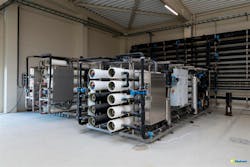Conductivity measurement in a water reuse plant: Precise measured values even in low measuring ranges
The production of frozen vegetables requires a significant amount of water. In order to save water, Belgium-based Pasfrost, which has been producing and distributing high-quality frozen vegetables since 1977, decided to reuse it. The water is purified in a water reuse plant, which includes a reverse osmosis system (RO). The core of the RO system is a membrane through which the water is filtered. A good condition of this membrane is a prerequisite for the proper functioning of the plant. With the help of Memosens conductivity sensors, the membrane condition can be monitored both reliably and easily.
Benefits of Memosens conductivity sensors
- Precise measurements — even of very low conductivity values.
- Plug-and-play, easy exchange of sensors and calibration in the lab — Memosens technology makes sensor handling convenient.
- Reliable conductivity measurements give clear indications about the membrane condition and thus about the functioning of the RO plant.
Customer challenge
Pasfrost processes fresh local vegetables into frozen vegetables. Therefore, many water-consuming process steps are necessary, such as washing vegetables and blanching them. Since the company is continuously growing, it built a new wastewater treatment plant. In addition, Pasfrost also has a water treatment plant where it purifies a large part of the process wastewater into drinking water, which is then reused. For purification, Pasfrost relies on technologies like ultrafiltration, UV disinfection and RO. Currently, multiple RO installations are running to purify a large part of the wastewater.
Water for reuse
Reverse osmosis is a water purification process that uses a partially permeable membrane to remove unwanted substances — such as ions, molecules or particles — from drinking water. Pressure is applied to overcome osmotic pressure. Unwanted substances are retained on the pressurized side of the membrane (concentrated wastewater), and the pure water can pass to the other side. The membranes’ status needs to be monitored to ensure pureness and to achieve high water quality. Therefore, conductivity is measured at the inlet of the RO and after a membrane. To fulfill the high hygienic requirements regarding drinking water, clean-in-place (CIP) is performed regularly at the RO installations. They are cleaned every few weeks with caustic soda or acid at 40°C. The conductivity sensors must be able to withstand this tough cleaning routine.
The solution
The challenge was to select suitable sensors that cover the broad range of conductivity values from incoming and outcoming water in the RO plant. At the RO inlet, a CLS21D sensor was installed, whereas at the outlet, the choice was a Memosens CLS82D. With the CLS82D, even lower conductivity values of purified water after the partially permeable membrane can be measured precisely. Both sensors, the CLS82D and CLS21D, are low maintenance and easy to use due to Memosens. Via the Liquiline CM44 transmitter, values are transmitted to the PLS that controls the membrane regeneration and CIP cycles automatically.
Conductivity values in the reverse osmosis installation
- Incoming water from the outlet of the wastewater treatment plant: 3000-5000 µS/cm
- Drinking water outlet: <2000 µS/cm
- Boiler feedwater outlet: <50 µS/cm
The results
With the help of the conductivity sensors, Pasfrost is able to monitor the proper functioning of its RO system. Thanks to water reuse, high-quality drinking water can be produced from recycled effluent constantly and reliably. Pasfrost takes only one-fourth of the total amount needed of freshwater from a well. The remaining three-fourths of the water demand are covered by the production plant’s own recycled water. Thus, Pasfrost is almost independent of the municipal water supply. The solution is both sustainable and cost effective.
“Endress+Hauser demonstrated again that they are able to provide the suitable product for each application. With the CLS82D we found the optimal sensor to ensure the drinking water quality,” said Pasfrost's Alexander Wallays.
Endress+Hauser is a global leader in measurement and automation technology for process and laboratory applications. Endress+Hauser devices, solutions and services can be found in many industries. Customers use them to gain valuable knowledge from their applications, and this enables them to improve their products, work economically and protect people and the environment.

